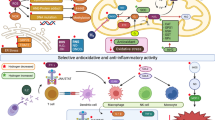Abstract
The susceptibility to ventricular arrhythmias under the conditions of cardiac ischemia and reperfusion was investigated in the Langendorff heart preparation of rats fed for eight weeks a standard chow enriched with 2% of pulverized wild garlic leaves. The isolated hearts were perfused with a modified Krebs-Henseleit solution. The incidence of ventricular fibrillation (VF) during 20 min occlusion of thedescending branch of the left coronary artery (LAD) was significantly reduced in the wild garlic group as compared to untreated controls (20% vs 88%). The same holds for the size of the ischemic zone (33.6% vs 40.9% of heart weight). In the reperfusion experiments (5 min after 10 min ischemia), ventricular tachycardia (VT) occurred in 70% of the wild garlic group vs 100% in untreated controls and VF in 50% vs 90%. The time until occurrence of extrasytoles, VT or VR was prolonged. No significant alterations in cardiac fatty acid composition could be observed. Although the prostacyclin production was slightly increased in hearts of the wild garlic group, inhibition of cyclooxygenase by acetylsalicylic acid (ASA; aspirin) could not completely prevent the cardioprotective effects suggesting that the prostaglandin system, does not play, a decisive role in the cardioprotective action of wild garlic. Furthermore, a moderate angiotensin converting enzyme (ACE) inhibiting action of wild garlic was foundin vitro as well asin vivo that could contribute to the cardioprotective and blood pressure lowering action of wild garlic. Whether a free radiacal scavenging activity of wild garlic is involved in its cardioprotective effects remains to be established.
Similar content being viewed by others
References
Isensee H, Rietz B, Jacob R: Antiarrhythmic effects of diets rich in polyunsaturated fatty acids (PUFA) or garlic. Internat. Congress on Phytotherapie, München, 1992
Isensee H, Rietz B, Jacob R: Antiarrhythmic actions of garlic (Allium sativum). Drug Res. in press, 1992
Johnston KM, MacLeod BA, Walker MJA: Effects of aspirin and prostacyclin on arrhythmias resulting from coronary artery ligation and infarct size. Br J Pharmac 78: 29–37, 1983
Coker SJ, Parratt JR: The effects of prostaglandins E2, F2, prostacyclin, flurbiprofen and aspirin on arrhythmias resulting from coronary artery ligation in anaesthetized rats. Br J Pharmac 74: 155–160, 1981
Linz W, Schölkens BA, Han YF: Beneficial effects of converting enzyme inhibitor, ramipril, in ischemic rat hearts. J of Card Pharm 8 (suppl 10): S91-S99, 1986
Hock CE, Ribeiro LGT, Lefer AM: Preservation of ischemic myocardium by a new converting enzyme inhibitor, enalaprilic acid, in acute myocardial infarction. Am Heart J 109: 222–228, 1985
Elbl G: Chemisch-biologische Untersuchungen pflanzlicher Inhibitoren des Angiotensin I Converting Enzyms (ACE) insbesondere die der Arzneipflanzen Lespedeza capitate (MICHX) und Allium ursinum (L). Inaugural-Dissertation, München 1991
McLennan PL, Abeywardena MY, Charnock JS: Dietary fish oil prevents ventricular fibrillation following coronary artery occlusion and reperfusion. Am Heart J 116: 709–17, 1988
Isensee H, Al Makdessi S, Jacob R: Effects of diets rich in Omega-3 and Omega-6 fatty acids on cardiac membrane phospholipids and susceptibility to arrhythmias in the rat. Internat. Congress on Omega-3 Fatty Acids. Metabolism and Biological Effets. Oslo/Norway, 1992
Langendorff O: Untersuchungen am überlebenden Säugetierherzen. Pfluegers Arch 61: 291–332, 1895
Manning SA, Hearse DJ: Reperfusion-induced arrhythmias: Mechanisms and prevention. J Moll Cell Cardiol 16: 497–518, 1984
Walker MJA, Curtis MJ, Hearse DJ et al.: The Lambeth Convention: guidelines for the study of arrhythmias in ischemia, infarction and reperfusion. Cardiovasc Res 22: 447–455, 1988
Folch J, Lees M, Sloane-Stanley GH: A simple method for the isolation and purification of total lipides from animal tissues. J Biol Chem 226: 497–509, 1975
Morrison WR, Smith LM: Preparations of fatty acid methylesters and dimethylacetals from lipids with fluoride-methanol. J Lipid Res 5: 262–270, 1964
Depierre D, Roth H: Fluorimetric determination of dipeptidyl carboxypeptidase. Enzyme 19: 65–70, 1975
Leprán I, Nemecz G, Koltai M, Szekeres L: Effect of a linoleic acid-rich diet on the acute phase of coronary occlusion in conscious rats: Influence of indometacin and aspirin. J Cardiovasc Pharmac 3: 847–853, 1981
Riemersma RA, Sargent CA: Dietary fish oil and ischaemic arrhythmias. J Int Med 225 (suppl 1): 111–6, 1989
Wagner H, Sendl A: Bärlauch und Knoblauch. Deutsche Apothekerzeitung 33: 1809–1815, 1991
Sendl A, Wagner H: Comparative chemical and pharmacological investigations of extracts of Allium ursinum (wild garlic) and Allium sativum (garlic). Planta med 56: 588–589, 1990
Bönner G, Rahn KH: Prostacyclin und Hypertonie. Springer-Verlag, Belin, Heidelberg, New York, London, Paris, Tokyo, Hong Kong, 1989
Linz W, Martorana PA, Schölkens A: Local inhibition of bradykinin degradation in ischemic hearts. J Cardiovasc Pharmacol 15 (suppl 6): S99-S109, 1990
Meerson FZ, Kagan VE, Kozlov YuP, Belkina LM, Arkhipenko YuV: The role of lipid peroxidation in the pathogenesis of ischemic heart damage and the antioxidant protection of the heart. Basic Res Cardiol 77: 465–485, 1982
Kourounakis PN, Rekka EA: Effect on active oxygen species of Alliin and Allium sativum (garlic) powder. Res Comm Chem Path Pharmacol 72: 249–252, 1991.
Author information
Authors and Affiliations
Rights and permissions
About this article
Cite this article
Rietz, B., Isensee, H., Strobach, H. et al. Cardioprotective actions of wild garlic (Allium ursinum) in ischemia and reperfusion. Mol Cell Biochem 119, 143–150 (1993). https://doi.org/10.1007/BF00926865
Issue Date:
DOI: https://doi.org/10.1007/BF00926865




